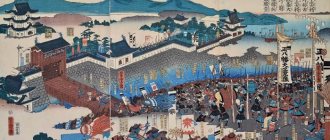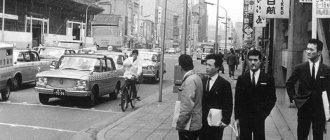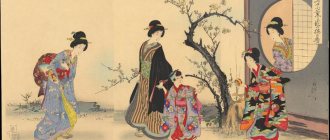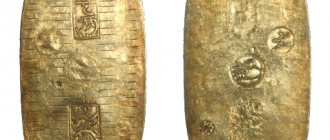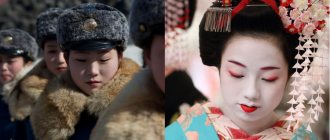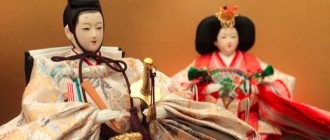End of political instability in Japan
Japan in the 17th century remained a fragmented state. And only in 1603, shogun Tokugawa Ieyasu managed to unite all the lands under his rule. The great feudal lord managed to achieve this through military campaigns and commercial activities. In the conquered territories, he established his own rules and took tribute from the local population, and took away mines for the extraction of precious metals from local feudal lords. Over the course of several years, Tokugawa Ieyasu managed to accumulate a large fortune, due to which he concentrated all power over Japan in his hands and held it until his death.
Sabotage occurred in the provinces, however, any manifestations of it were severely punished by the central government. The conspirators united under the leadership of the previous ruler, Hideyori. He believed that the Tokugawa seized power in Japan illegally in the 17th century, so he turned to Christians for help, who promised him to carry out a coup. In 1615, Tokugawa Ieyasu brutally suppressed the uprising, killing all the conspirators. The leader of the uprising, Hideyori, committed suicide.
Thus, the uprising in Ieyasu in 1615 put an end to political instability in the country, and from that moment a new page began in the history of Japan.
Economic development of medieval India
The pace of development of feudalism in different parts of India was not the same, since the tribes and nationalities that inhabited the country in the 6th century were at different levels of economic development and political power in the North and South of the country was unstable.
The paradox was that political instability did not in any way disrupt the stable type of economic relations. This is, first of all, the dependence of the economy on the varna-caste system, the specifics of the Indian agricultural community and its place in the economic structure of society, the specifics of the institution of power and property.
It is known that the communal form of organization of farmers is universal, and therefore what was characteristic of India was not the very fact of the presence of an agricultural community there, but the place this community, thanks to Varna-caste relations, occupied in the economic structure of the country. The internal life of this organism obeyed the principle of janzhmani, only recently discovered and studied by specialists. The nature of janzhmani was reduced to a strictly obligatory mutual exchange, a strictly and clearly regulated order for centuries in the exchange of products and services necessary for everyone within the closed framework of the community.
Early feudal India
In early feudal India, the relationship between producers and the state was specific. There was an institution of “power-property” in the country. This meant that the maharajas and other rulers were subjects of power-property, which coincided with sovereignty. The material expression of this was rent-tax and various duties from subjects.
Communities paid the state the traditional 1/6 of the harvest, and this was also the duty on the income of the urban population. Taxes both in the city and in the countryside were paid by the propertied.
The “Golden Age” of India, as the Gupta Empire was called, was from the 7th to the 12th centuries. was replaced by a period of fragmentation and at the same time the development of port trade. Feudal landownership grew. But along with the ever-growing feudal lords and large landowners, at that time the Indian community was still relatively independent, large in size and with autonomous self-government. Each community member owned his field by inheritance, and trade transactions with the land were controlled by the community administration.
During this period, city life was revived, port cities developed, new cities emerged next to the castles of landowners, in which artisans settled to serve the needs of the court and the feudal lord's troops. Exchange between cities is intensifying, crafts are developing, and groupings of artisans by caste are being formed.
Socio-cultural situation in the country
The new ruler Ieyasu began with reforms. First of all, he took up the social sphere. Then he reformed culture, religion and social activities.
Ieyasu's reforms in the social sphere:
- Streamlined the country's governance system. The shogun took the place of the emperor. Executive power was now concentrated in the hands of the minister, onto whose shoulders the duties of an adviser fell.
- He divided society into 4 classes: merchants, artisans, peasants and samurai. The dominant role in society, naturally, was occupied by samurai. The role of women in Japan in the 17th century was limited to looking after children and performing household chores. Their husbands were samurai and spent most of their lives on military campaigns.
As for the cultural development of Japan, during the reign of the Tokugawa regime, Confucian ideas began to spread in the Land of the Rising Sun under the leadership of the philosopher Zhu Xi. In addition, nationalist ideas began to strengthen in Japan. At the beginning of the 17th century, these ideas did not carry extremism and were aimed at searching for national self-identification. From peaceful nationalist ideas in the 18th century, they developed into a theory of Japanese superiority over the Chinese and Koreans.
A rather interesting doctrine that appeared in the 17th century is the shingaku ethics, thanks to which the modern mentality of the Japanese was formed. It has become something like every Japanese's own ideology. Then they believed that one could achieve one’s own well-being only through hard work, frugality and personal intelligence. In addition, in Japan the search for national self-identification continued in the cultural sphere. Cultural figures studied national ancient monuments, explored the history and spiritual culture of their people. Passion for one's own culture led to the emergence of the Koku-Gaku school, which advocated the search for national identity.
Economy of Medieval China
Three Kingdoms Period
In the history of China, the boundary between Antiquity and the Middle Ages falls on the centuries. Early feudalism went down in history as the Three Kingdoms (220-280). At this time, three states emerged here: in the north - Wei, in the central part - Shu and in the south - Wu. These were states of military dictatorship.
At the end of the 4th century. In the north of China, the Northern Wei Empire was founded, led by Tu Gui, an energetic reformer in foreign and domestic policy known in Chinese history. To provide the capital with grain, he formed settlements around it of resettled farmers, who were allocated land at the expense of the state. During this migration, over a million people moved to the south of the country, with the richest and most educated Confucians. The resettlement sites were almost undeveloped fertile valleys, where the new owners began to grow rice, which has since become one of the main crops of the country, and the rice belt eventually became the main breadbasket of the empire.
Along with the development of agriculture, cities began to be built in the southern lands, crafts, trade and commodity-money relations began to develop. This was a period of flourishing culture, especially in the south, and the strengthening of a new religion in China - Buddhism.
The allotment system was opposed by the process of growth of private agriculture - the so-called strong houses, which was accompanied by the ruin and enslavement of the peasantry.
The differentiation of the population led to an increase in the number of disadvantaged layers, which were called “mean people.”
Imperial period (late VI - XIII centuries)
At the end of the 6th century. The commander of one of the northern kingdoms, Yang Jian, united all of Northern China under his rule, proclaimed a new Sui dynasty, and then restored the political unity of the country and became the ruler of all of China. This ruler, who took the name Wendi, carried out reforms aimed primarily at resolving pressing issues of land use. The principle of his policy was to provide each plowman with a land plot.
During Wendi's reign, due to the increase in the size of plots, the number and size of cultivated land increased significantly. Thus, for the first time, the population census revealed 1.5 million peasants who were not previously included in the lists of the tax-paying population. Allowing them with land significantly replenished the treasury, although not all land received from the state was cultivated by peasants. A significant part of the peasants still cultivated the lands of officials and powerful houses, although the era of their prosperity was passing, the power of an extremely centralized state was increasing.
The initiated policy of strengthening centralized power continued under Wen-di's successor, Yang-di, who continued it by force.
Yang-di's policy was aimed at relocating the most influential families to a new place, tearing them away from their native places and putting them under the control of the authorities.
Chinese historians call the Tang period the “golden age of Chinese feudalism,” linking this with the human merits of the emperors of the Tang dynasty. Thus, the Chinese Encyclopedia of 1987 notes that the second emperor of this dynasty, Li Shi-min (Tai-tsung), was the greatest of the emperors of China, because he had two positive qualities: the ability to choose good people to serve and the ability to accept criticism. It was he who laid the foundation for the prosperity of the Chinese empire. The peace and order he established in the country made it possible to concentrate efforts on the sphere of production. Agriculture begins to flourish, crafts and trade develop.
All land in China was state-owned, and plots were considered temporary, being provided to the farmer only for the period of his ability to work, and then redistributed, for which strict registers were kept. Mutual responsibility and everyone's responsibility for paying taxes and other duties were restored. The complexity of land use in China was compensated by its strict regulation, the supervision of which was entrusted to a huge army of well-trained officials appointed from the center. One of the functions of the bureaucrats was to monitor processes on state-owned lands. These lands were either distributed for hereditary use to the titled nobility, or were provided for the use of officials for the duration of their service. However, according to Chinese legal norms, the degree of nobility decreased with each generation, and after five generations it disappeared. In this case, the lands were returned to the treasury and officials were obliged to monitor this process.
Successful land use and ever-increasing tax revenues to the treasury contributed to the development and complexity of infrastructure: first of all, cities developed where trade, crafts, and construction flourished. Government crafts also developed, where they mainly worked as labor conscription.
A clear specialization also existed in the work of officials, and it corresponded to the administrative structure of the state. This structure was multi-stage, but very logical.
A situation arose when the superstructural factor (meritocratism, education, adherence to the principles of Confucian doctrine) had a decisive impact on the state of the economy, and not vice versa. The Chinese economy flourished during this period in the 8th century. This was the time of the re-opening of the Great Silk Road, the restoration of China's power as a great Asian power. The peak of development occurred during the reign of Emperor Suanzong (713-756), during which the state received high revenues to the treasury from the mining of tin, iron, copper, and silver. Mining, crafts and trade developed. The city became rich, and layers of wealthy craftsmen and merchants grew. According to the census of 754, there were 9,610 thousand households in the country, 52,880 thousand people were taxed.
However, in the second half of the 7th century. Signs of an approaching crisis appear, the power of the emperor weakens and military governors acquire greater power in the outlying areas.
The main symptom of the crisis was the deterioration of the situation in agriculture. The state allotment system begins to die out and the local form of farming begins to strengthen. The practice of buying and selling plots acquired by officials, moneylenders, and city merchants is spreading.
The reform of 780 made peasant lands subject to purchase and sale, although state control over these processes continued to exist.
Contradictory processes took place: lands were sold relatively freely (compared to previous times) and intensively bought up by landowners, but the state was not interested in this.
The reforms also affected other economic areas: trade credit developed, bills of exchange appeared, usury operations intensified, and state monopolies on tea, salt and vodka were introduced.
Although the process of economic development continued, trade flourished. Many foreign merchants and travelers came to China, leaving valuable records of observations about Chinese society and the prosperity of the country. Among them are the testimonies of the Moroccan Ibn-Batug and the book “Travels” by the Venetian Marco Polo.
Gold, silver, silks, porcelain were exported from China, ivory, medicines, and spices were imported. Trade developed - cities grew, became richer and more populous, and new ones were built. Crafts developed. The products of Chinese artisans to this day constitute national pride. This is the famous Sung porcelain, items made of lacquer and ivory, and exquisite fine silks.
The mining industry received particular development, and the extraction of silver and iron increased. Silver and silver products were used to pay off the conquerors, and iron was used to make weapons.
As a result of the development of commodity-money relations, the need for money increased, but insufficient copper production prevented the production of copper coins in the required quantity. The increase in iron production made it possible to expand the production of iron money. At the end of the 10th century. paper money appeared.
The development of crafts increased the number of state-owned workshops. The number of workers in shipbuilding workshops reached 600-700. At enterprises producing weapons and minting iron coins, the use of hired labor was practiced. The wages were partly in kind, partly in cash.
Significant successes were noted at this time in agriculture. Achievements in the agricultural sector, like other cultural achievements of this period (the invention of gunpowder, the compass, printing), occurred simultaneously with the growing crisis (the number of peasant landowners decreased and the number of landless tenants increased).
Decline of the Chinese Empire
For over 70 years the Mongols tried to conquer China. In 1280, China fell completely under the rule of the Mongols, Kublai Khan became the Chinese emperor of the Mongol Yuan dynasty.
In the first years of Mongol rule, the country's economy fell into decline, and damage was done to agriculture and crafts. It took several decades to restore all this.
With the creation of the rice belt in southern China, irrigation began to play a major role in the country's economy, which also served as a defense against rivers, especially the Yellow River, which periodically overflowed their banks and flooded the country. All Chinese governments have always taken care of water construction, clearing riverbeds, and repairing canals. The Mongols did not do this, and the results were immediate. In 1334, hundreds of thousands of people died in the waters of the Yellow River, which broke through a dam. This caused a new explosion of popular discontent, resulting in an uprising that ended with the defeat of the Mongols and the proclamation of a new Ming dynasty (1368-1644).
The first emperor of this dynasty, Zhu Yuan-chang, took the entire system of agrarian relations under strict control of the central government. All peasants received land, the landless were resettled on empty land, and all-China tax and land registries were created. Taxes were moderate, and many households were generally exempt from them.
Isolation of Japan
In the early years of his reign, Shogun Ieyasu supported trade with Europeans, although he did not want to deal with them. The new ruler of Japan even dreamed of making the city of Edo the main port of the country, but trade disagreements with China provoked him to take control of all trade with foreigners.
In 1612, Shogun Ieyasu allowed Christians to trade only a certain group of goods, and then not in all cities. The new ruler ordered the peasants living in Japan to renounce their faith. The disobedience of ardent Christian believers triggered a series of reprisals against defenseless ministers of a foreign church. Samurai professing the Christian faith rose up to defend unarmed Christians. The largest revolt ended with the defeat of the rebels in the city of Shimabara in 1638. From that moment on, Christianity was banned in the country. The final closure of Japan in the 17th century dates back to 1641, when any contact with the outside world was limited to a small port on the island of Dejima.
Reasons for Japan's closure:
- The need to strengthen the power of the shogun.
- Shogun Ieyasu was a supporter of nationalist ideas, so he decided to protect his country from “obsessive Christians” in this way.
- Despite the slight revival of trade with the outside world, the mentality of the Japanese population remained unchanged - most of society was in favor of closing the country.
Japan went through difficult times in the 17th century - the government completely changed in the country, a new ideology reigned in the form of Confucianism, and brutal reprisals against peasants began.
General state of the Japanese economy
Note 1
The Japanese economy today is one of the most developed in the world. In terms of participation in the global gross product, it is second only to China and the United States.
The main emphasis in the country is on high technology and the provision of various types of services, as well as automobile construction and shipbuilding. A fairly large share of the world's fisheries comes from Japan. The state provides comprehensive support to agriculture. However, due to territorial characteristics, about fifty percent of food and goods in this area are imported into the country.
The country has a fairly developed sector of medium and small businesses. Moreover, they are present in almost all industries and fields of activity. The development of these forms of business provides a powerful impetus for stabilizing the economic situation, as well as maintaining a high level of competition. Competition, in turn, encourages manufacturing and services to innovate and find new ways of doing business and creating products.
Finished works on a similar topic
Coursework History of economic development of Japan 490 ₽ Essay History of economic development of Japan 270 ₽ Test paper History of economic development of Japan 250 ₽
Receive completed work or specialist advice on your educational project Find out the cost
By the end of the twentieth century, highly liquid cash reserves in Japan had grown significantly, which began to be exported abroad for investment purposes. At the moment, the state is one of the strongest players in the global market of banking and lending services. Capital exports account for the majority of the country's income.
A feature of the Japanese economy is its complete dependence on imports of raw materials, energy resources and minerals. At the same time, the country is one of the world's largest importers of industrial products. Japan exports:
- products of the engineering industry;
- microcircuits;
- cars;
- steel;
- chemical industry products.

